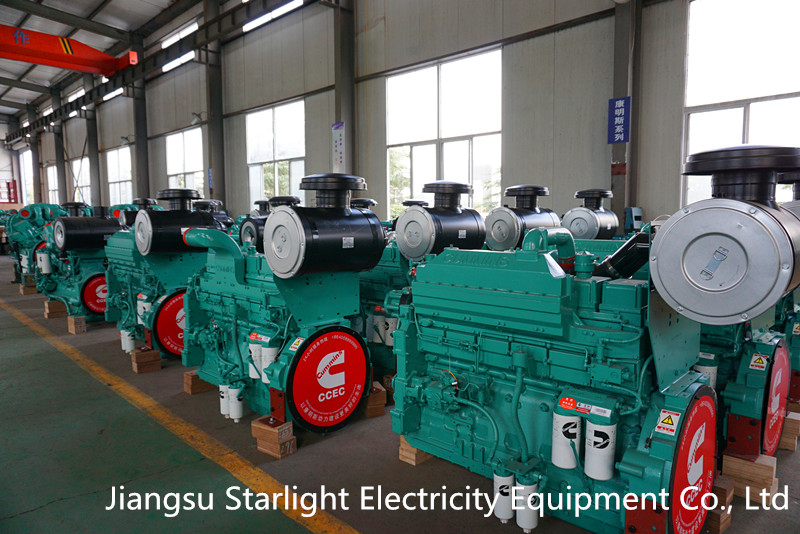We know that lubricating oil is very important for an engine or a diesel generator. Learning the correct oil storage methods is necessary to avoid machine damage.
Drums, pails and cases of lubricating oil are supplied in leak-proof, labeled containers. Careless handling however, can cause teaks, lubricating oil contamination and label damage.
Correct unloading prevents damage to lube drums and personnel. Hydraulic gates on delivery vehicles, or hand winch hoists, lower drums to the ground or unloading platform safely. Lube drums can also be unloaded by sliding down skids. Before unloading with skids, set truck brakes or freight-car bed securely. Never allow a lube drum to skid or roll under its own momentum.
Once unloaded, lube drums should go immediately to storage, preferably with a fork truck, with drums secured on pallets or held by fork jaws. Jaws need adapters that take the shape or curvature of the lube drum; standard straight jaws require too much squeeze pressure to keep lube drums elevated. If fork trucks are unavailable, use barrel trucks or drum handlers.
If the floor between unloading and storage is flat and smooth, drums can be rolled into storage. The drums' hoops ("chimes") protect it, but avoid rolling the lube drum over sharp objects.
And don't allow the lube drum to slam on the ground when re-positioning it from upright to its side. Two workers should handle re-positioning and rolling, and maintain firm control of drum speed.
Pails and kegs of lubricants arrive on pallets; smaller containers of lubricating oil arrive in fiberboard cartons. All lube containers should be handled with the care given drums. Cartons should remain sealed until inside the storage area.

Recommended product: Cummins diesel generator 300KW
Indoor Lubricating Oil Storage
Store lube in one designated area to simplify control and inventory management. Racks and shelving that adequately protect containers should be provided, along with a device to hoist the lubricant drums. Avoid storing lubricating oil near steam lines or heaters.
Outdoor Lubricating Oil Storage
Storing lubricating oil outdoors is discouraged. If lube must be stored outside, take these
precautions:
A temporary shelter or waterproof tarpaulin protects lube drums from weather. Place lube drums on blocks or racks several inches above the ground to prevent moisture from contaminating the lubricating oil. Place lube drums on their sides with bungs (port holes) horizontal to each other. For maximum protection, place lube drums on end (bung end down) on a well-drained surface.
If the lube drums are stored on end with bungs on top, water may seep into drums through the bungs and destroy contents, or form rust on the drum's interior. Rain or condensation which collects inside the chime can draw down through the bung as the drum breathes with the rise and fall of pressure and temperature. (This occurs even if drums have never been opened!)
Drums stored outdoors with bung end up should be tilted on blacks, with bungs parallel to the block to keep water from bung openings.
Bulk Lubricating Oil Storage
Bulk quantities of lube are delivered in tank trucks or railroad cars and pumped into tanks or bins. Unloading bulk lube requires caution, so only trained employees should be involved.
Bulk lube should not be stored outdoors because of the risk of water contamination as vents and filler openings at the top of the storage tanks breathe. Temperature extremes and changes also have adverse effect on bulk lube, as in drums. If outdoor storage is necessary, all openings on the bulk tanks should be checked for tightness and secured. A tarpaulin or roof over the tanks will help protect against weather.
Storage vessels in a warehouse or oil house should be away from steam lines, heaters and equipment that generates heat. Tanks should not be stored in cold areas either, or where temperatures cycle from hot to cold extremes.
Avoid galvanized tanks or piping to store lube containing additives which react with zinc to form soap-like sludge in the lubricating oil.
Even indoors, moisture can condense inside lube tanks. Minimize moisture intake with desiccant breathers and remove condensate through the bottom drain, or pump out with bottom-fed pumps. In grease bins, condensate can be siphoned off the top. Either way, it's important to remove water promptly to prevent rust formation inside the bin and lubricating oil contamination.
Lubricating Oil Identifiers
Each oil should be stored in special containers, and identify its name on containers. Such as barreled oils, should identified name and grade on lube barrels. Plain use oil only need to identify D, F, H or I grade on lube barrels. Tableland use oil should identify D grade tableland oil (cold zone use),or F grade tableland oil (cold zone use),H grade tableland oil (cold zone use), I grade tableland oil(cold zone use) on lube barrels.
Waste oil or feculency must be collected in labeled containers. Be careful of pacing waste oil and new oil dividually, avoid new oil to be polluted.
There should have a record table for lubricating oil distributive quantity and each engine operation, to inspect the oil consumption well-balanced, When the consumption has distinct change, investigate and analysis should be taken in time. If the reason caused by degenerated or metamorphosed, the oils must be discarded as useless.
Maybe You Also Like: Function of Cummins Engine Oil
Copyright © Guangxi Dingbo Generator Set Manufacturing Co., Ltd. All Rights Reserved | Sitemap
Update cookies preferences